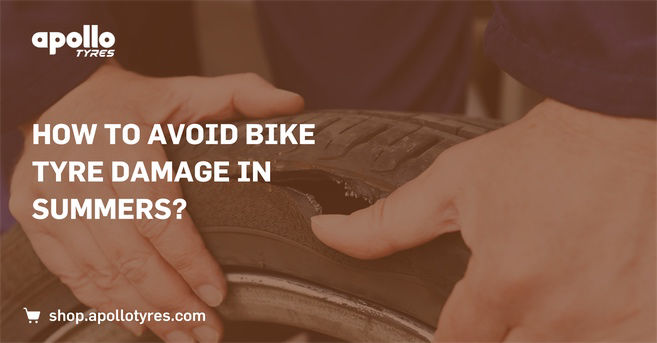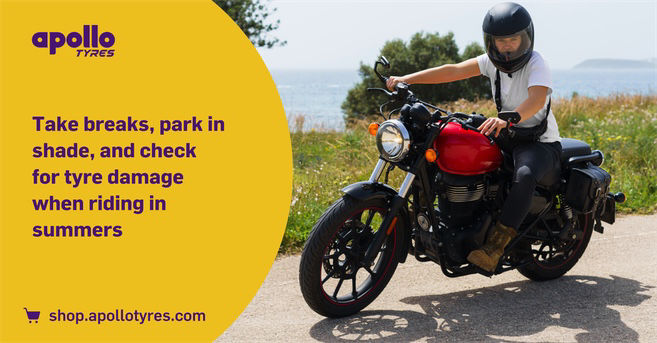
Summers can get exceptionally hot in India, and so can the tarmac. Every summer we hear crazy stories about the asphalt melting of the roads or people frying eggs on the sidewalk due to the rising temperatures. But can it get so hot that it actually affects your bike’s handling and control?
Unfortunately, the answer is yes. Excessive hot weather during summers can make your tyres explode. Bike tire bursts, also known as blowouts, can be dangerous and potentially life-threatening.
Most common reasons for bike tyre blowouts in India
Prolonged exposure to high temperatures in hot weather can affect the tire's integrity, leading to a higher risk of a blowout. Apart from that there are cause of bike tire bursts in India, some of which are typical to our riding habits:
Overloading: Overloading the bike with excessive weight beyond its recommended capacity puts significant stress on the tires. This can lead to increased heat build-up and friction, eventually causing the tire to burst.
Underinflation: Riding a bike with underinflated tires is one of the most common causes of tire bursts. Low tire pressure causes the tire sidewalls to flex excessively, leading to heat build-up and increased chances of a blowout.
Puncture and Damage: A punctured tire, especially when not repaired promptly or adequately, can weaken the tire's structure, making it more susceptible to bursting.
High-Speed Driving: Riding at very high speeds generates more heat in the tires. If the heat exceeds the tire's capacity to dissipate it, the tire's structural integrity can be compromised, leading to a blowout.
Poor Tire Quality: Low-quality or counterfeit tires may not have the necessary build and safety standards. These substandard tires may fail unexpectedly, leading to a blowout.
Age of the Tire: Old tires with significant wear and tear lose their flexibility and become more prone to failure, including blowouts.
Road Conditions: Riding on poorly maintained roads with potholes, debris, or sharp objects increases the risk of tire damage, increasing the likelihood of a blowout.
Tire Damage from Curbs or Obstacles: Impact with curbs, speed bumps, or other obstacles can cause internal damage to the tire, leading to a potential blowout over time.
Why tyres blowout in extreme heat?
Scientific research shows that for every 10° F rise in temperature, the tyre pressure increases by one PSI (pound per square inch). The air pressure keeps on increasing once the summer temperatures start soaring. While the ratio of increase may not seem significant, passenger vehicles generally have 30 to 35 PSI pressure in tyres. Thus, a few pounds of extra air pressure can make a big difference. Even if the tyres do not blow out, overinflation can eventually lead to premature wear and hamper cornering and braking performance.
Tyres also generate internal heat
Besides the rise in temperature, there are other factors that heat up the tyres, such as,
Friction: As you ride your bike, the tires make direct contact with the road surface, creating friction that propels the vehicle forward. Friction plays a crucial role in enabling the bike to move, but it also comes with its challenges. The interaction between the tire and the asphalt generates a significant amount of heat, especially when using non-tubeless bike tires.
Rubber compounds: The primary material used in tire construction is rubber, and it plays a vital role in determining tire performance. Rubber consists of long, twisting chains of molecules called polymers. When the wheel rotates, the polymers experience vibrations and contract. Tire manufacturers design the rubber to handle the inward coiling of molecules caused by this movement. However, it is essential to recognize that even though tire rubber is engineered to withstand these forces, there is still a breaking point beyond which the rubber can be compromised.
Advantages of Having Tubeless Bike Tires
In the last decade, tubeless radial bike tires have gained popularity due to their ability to reduce friction-related heat buildup. Without the presence of an inner tube, there is less heat generated through friction between the tube and tire. Moreover, tubeless tires have the advantage of self-sealing punctures, which can further enhance safety and convenience during rides.
How to avoid tyre damage or blow out during summers?

During or after long rides in hot weather, touch the bike tyres with your hand. If they feel excessively hot to touch, it may indicate overheating. In such cases, stop riding and allow the tyres to cool down before continuing your journey. You can also use an air pressure gauge to check for over-inflation during summers to see if the heat is affecting the PSI. There are several other things you can do to avoid bike tyre damage in summers:
- Check Recommended Air Pressure: Refer to your motorbike's manual to find the recommended air pressure for your tyres. Regularly check and maintain proper tyre inflation, ensuring they are not underinflated or overinflated. Keep an eye on the PSI and make stops at petrol pumps or tyre shops to monitor tyre pressure during long rides.
- Plan Your Rides: If possible, plan your rides during cooler parts of the day, such as early mornings or late evenings, to avoid the peak heat of the day. Reducing exposure to extreme temperatures can help preserve the tyres' performance.
- Let Tyres Cool Down: During long-distance rides in hot weather, take regular breaks to allow the tyres to cool down. Avoid the mistake of letting air out when tyres become over-inflated due to external heat, as it may lead to under-inflation, which is equally dangerous. When parking your bike, choose shaded areas whenever available to protect the tyres from direct sunlight. Prolonged exposure to intense heat can lead to tyre degradation and reduced lifespan.
- Use High-Quality Tyres: Invest in premium-quality bike tyres known for their heat resistance and durability, such as Apollo Tramplr tyres. Quality tyres with advanced rubber compounds and innovative tread designs perform better under high-temperature conditions.
- Use Wax-Based Products: Treat your tyres with wax-based products to prevent them from drying out. This helps maintain the tyre's flexibility and reduces the chances of blowouts caused by dry and brittle rubber.
- Avoid Overloading: Respect the bike's weight limit and avoid overloading it with excessive weight. Overloading puts extra stress on the tyres, leading to increased heat buildup and a higher risk of tyre failure.
- Drive Smoothly: Adopt smooth and controlled driving techniques to minimize friction and excessive heat generation. Avoid sudden acceleration, harsh braking, and sharp turns, as aggressive driving can lead to increased tyre temperature.
- Inspect Tyres for Damage: Routinely inspect your bike tyres for signs of wear, damage, or punctures. Look for bulges, cracks, cuts, or any foreign objects lodged in the tread. If you notice any irregularities, have the tyres inspected and repaired or replaced as needed.
- Consider New Tyres: Older tyres with worn-out tread may not efficiently dissipate heat, increasing the risk of blowouts. Newer tyres, especially those with highly durable rubber compounds and innovative tread patterns, are better at handling heat. Consider replacing your bike tyres with quality options, before the summer season starts.
In search of new bike tyres online in India?
If your bike tyres are experiencing overheating or wear and tear, and you wish to find new motorcycle tyres online, visit our website at shop.apollotyres.com. Our online tyre shop enables you to compare bike tyre prices and offers the finest deals on purchasing new tyres. Additionally, you will receive all standard warranty and service benefits, just like those provided at authorized Apollo Tyre shops near your location.
Frequently Asked Questions:
At what temperature do tires blowout?
Tires can blow out at various temperatures, but the risk of a blowout increases significantly in extremely hot conditions. As a general guideline, tire blowouts can occur when the external temperature reaches around 140 to 160 degrees Fahrenheit (60 to 71 degrees Celsius). However, other factors such as tire age, tire condition, road conditions, and driving speed also play a role in determining the risk of a blowout.
Is it safe to bike ride in extreme heat?
Biking in extreme heat can pose certain risks and challenges. High temperatures can lead to increased heat buildup in the tires, potentially affecting tire performance and safety. Additionally, extreme heat can cause dehydration and heat-related illnesses for the rider. To ensure safe biking in hot weather, it's essential to stay hydrated, wear appropriate clothing, use sunscreen, and avoid riding during the hottest parts of the day. Regularly check tire pressure and condition to minimize the risk of tire failure due to heat-related issues.
How much heat can a tire take?
Tires can tolerate a certain amount of heat generated during friction without significant issues. The heat resistance of a tire depends on the quality of the tire construction, the rubber compound used, and the speed and load at which the tire operates. High-quality tires designed for specific purposes, such as high-performance tires, generally have better heat resistance. However, it is essential to operate within the manufacturer's recommended speed and load limits and maintain proper tire inflation to prevent excessive heat buildup that may lead to tire failure.
Can a bike tire pop from too much air?
Yes, a bike tire can pop from overinflation. If a bike tire is inflated well beyond its recommended pressure, the excess air pressure can cause the tire sidewalls to bulge excessively, weakening the tire's structure. This can lead to a blowout or sudden failure while riding, posing a safety hazard to the rider. It is crucial to follow the recommended tire pressure specified by the bike manufacturer or tire manufacturer to ensure safe and optimal performance. Regularly check tire pressure using a reliable pressure gauge and avoid overinflating the tires.

